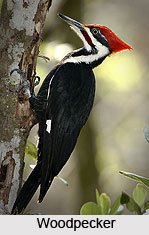 Woodpeckers are insectivorous birds of well wooded country (Family Picidae). They live in tree cavities and in the desert regions. Some of the species form their nests in holes in cactus and some nest in earthen holes. The Indian sub region is particularly rich in woodpeckers. Woodpeckers are noted for their ability to acquire wood-boring grubs using their bills for hammering. They are characterized by their dietary flexibility.
Woodpeckers are insectivorous birds of well wooded country (Family Picidae). They live in tree cavities and in the desert regions. Some of the species form their nests in holes in cactus and some nest in earthen holes. The Indian sub region is particularly rich in woodpeckers. Woodpeckers are noted for their ability to acquire wood-boring grubs using their bills for hammering. They are characterized by their dietary flexibility.
Physical Features of Woodpecker
Woodpeckers have short legs, zygodactyls feet (two toes in front and two behind) and sharp curved claws for clinging to and climbing tree trunks. They have a stiff pointed tail to serve as a tripod support in this activity. The chisel-shaped bill, specially adapted for digging in wood, and worm-like, barb-tipped extensile tongue capable of being shot out beyond the bill tip, enable the bird to skewer out hidden beetle larvae from the borings.
Types of Woodpecker
There are fifteen genera and thirty two species ranging from the crow-sized Great Black woodpecker (Dryocopus javensis) and the Himalayan Slaty Mulleripicus pulverulentus to the diminutive sparrow-sized Spotted and Rufous piculets Picumneus innominatus and Sasia ochracea. Woodpeckers are highly beneficial to forests in controlling timber pests. Enlightened forestry practices recognize their usefulness by leaving a few mature native trees standing for the birds to nest in amidst areas clear-felled for monoculture.
There are in all, two hundred species and about thirty genera of woodpeckers in the family and most of the species of these birds are threatened or endangered because of the loss of habitat. Two of the species, the Imperial Woodpecker and the Ivory-billed Woodpecker, are regarded as extinct for thirty years. The Bar-breasted Piculet is the smallest woodpecker, at seven gram and eight centimetres and the Imperial Woodpecker is the largest, at fifty eight centimetres and about six hundred grams. These birds range from extremely antisocial solitary species being aggressive to some of the other members which live in groups.
Diet of Woodpecker
Their food comprises of insects and their grubs which are collected from dead or living trees, and several arthropods, nuts, and fruits from living trees, and sap from live trees.



















